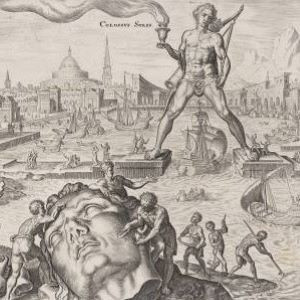The legendary Wonders of the World, imposing monuments of ancient history, have elicited admiration and whetted the imagination of artists ever since the times of Antiquity. The number and composition of the Wonders changed over time. The classic list of the Seven Wonders of the World comprises: the Great Pyramid of Giza (the only surviving one), Hanging Gardens of Babylon, Temple of Artemis at Ephesus, Statue of Zeus at Olympia, Mausoleum at Halicarnassus, Colossus of Rhodes and the Lighthouse of Alexandria. With the exception of the pyramid, these architectural and artistic works have not survived and their later representation was very much based on the artists’ imagination. An awareness about the astonishing monuments of the bygone times survived the Middle Ages and the notion of the World’s Wonders was re-awoken in the culture of Humanism. This theme was rediscovered for the visual arts by the Dutch painter Maarten van Heemskerck who, in partnership with the engraver Philips Galle, published a series of engravings known as The Eight Wonders of the World (1572). In the early 17th century, two more cycles were issued; a series of engravings after Maarten de Vos (1614) closely emulating Heemskerck’s work and the more inventive cycle by Antonio Tempesta (1608). A selection from these three print series will form the core of a small exhibition on view in the Graphic Art Cabinet. Valuable prints loaned from the collections of Royal Canonry of Premonstratensians at Strahov in Prague will also be exhibited.
Miracula mundi. The Wonders of the Ancient World in the Graphic Art of the 16th and 17th Centuries
National Gallery Prague - Schwarzenberg Palace, Hradčanské náměstí 1, Praha 1
February 22, 2022 - May 22, 2022
 |
Miracula mundi. The Wonders of the Ancient World in the Graphic Art of the 16th and 17th CenturiesNational Gallery Prague - Schwarzenberg Palace, Hradčanské náměstí 1, Praha 1February 22, 2022 - May 22, 2022
Curator: Petra Zelenková
|


